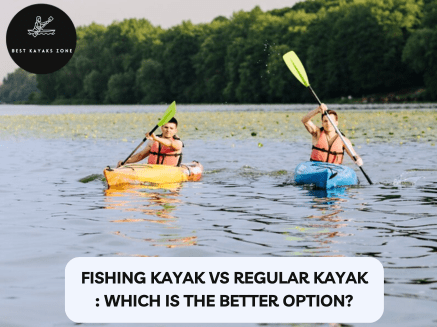
Tessa Young
Kayak Expert

John Smith
Expert Reviewed |Kayak Expert
Update
When deciding between a fishing kayak vs regular kayak, it all comes down to your needs. Fishing kayaks offer stability and features designed for anglers, while regular kayaks focus more on speed and agility. Understanding the differences between fishing kayaks and regular kayaks will help you choose the better option for your adventures on the water.

On This Page
What is a Regular Kayak?
A regular kayak, often termed a recreational kayak, is a vessel designed for the casual paddler. It’s the quintessential image of kayaking—a sleek, often streamlined craft, built for versatility on calm waters. Regular kayaks are typically constructed with a focus on stability and ease of use, making them ideal for those who want to explore lakes, slow-moving rivers, or sheltered coastal areas.
Their design is straightforward, often featuring a sit-in cockpit where the paddler is enclosed, offering protection from the elements while maintaining a low center of gravity for balance. These kayaks are crafted from materials like polyethylene or composite blends, ensuring durability while keeping them lightweight and manageable.
Pros and Cons of Regular Kayaks
Pros
Versatility:
Regular kayaks, often referred to as recreational kayaks, are designed to be versatile, accommodating a wide range of activities such as casual paddling, exploring lakes and rivers, or even light touring. Their adaptability makes them popular for beginners and those who enjoy various water-based activities.
Ease of Use:
These kayaks are generally shorter and wider than specialized models, making them easier to maneuver and control. Their user-friendly design allows even novice paddlers to learn and feel comfortable on the water quickly. The simplicity of their operation makes them ideal for casual outings or family use.
Affordability:
Regular kayaks are typically less expensive than specialized kayaks, such as fishing or touring models. Their lower cost makes them accessible to a broader range of people, including beginners who may not want to invest heavily in a specialized kayak until they are more experienced.
Lightweight and Portable:
Many regular kayaks are made from lightweight materials, making them easy to carry, load onto a vehicle, and store when not in use. This portability allows paddlers to easily access different waterways without the need for specialized transportation equipment.
Low Maintenance:
Recreational kayaks are designed with durability and low maintenance in mind. Constructed from materials like polyethylene, they are resistant to impacts and scratches, requiring minimal upkeep. This durability ensures that the kayak remains in good condition over time, even with frequent use.
Cons
Limited Performance:
While regular kayaks are versatile, they may not perform as well in specific conditions or activities. Their design prioritizes stability and ease of use over speed and agility, making them slower and less efficient for long-distance paddling or navigating rough waters. This can be a disadvantage for those seeking more dynamic kayaking experiences.
Less Storage Capacity:
Compared to specialized kayaks, regular kayaks often have less storage space. While they may include basic storage options like a small hatch or bungee cords, they generally lack the extensive storage solutions found in fishing or touring kayaks. This limitation can make it challenging to carry gear for longer trips or more specialized activities.
Basic Features:
Regular kayaks are typically equipped with basic features, lacking the advanced customization and accessories available in more specialized models. This simplicity can be a drawback for paddlers who require specific gear or want to tailor their kayak to particular activities, such as fishing or long-distance touring.
Less Stability in Rough Conditions:
While regular kayaks are stable in calm waters, they may struggle in rougher conditions such as strong currents, waves, or high winds. Their design, while stable enough for casual paddling, may not provide the same level of security and control as a fishing kayak in these challenging environments.
Not Ideal for Specialized Activities:
Regular kayaks are a jack-of-all-trades but master of none. While they are suitable for general use, they may not be the best choice for specialized activities like fishing, sea kayaking, or whitewater paddling. Paddlers with specific interests may find regular kayaks lacking in the features and performance needed to fully enjoy their chosen activity.
What is a Fishing Kayak?
Fishing kayaks are purpose-built vessels designed to enhance the angling experience. Unlike regular kayaks, these are outfitted with an array of features that cater specifically to the needs of anglers. Fishing kayaks are often wider, offering exceptional stability, which is crucial when casting a line or reeling in a catch.
The design typically includes multiple rod holders, gear tracks for mounting accessories, and ample storage compartments for tackle boxes, bait, and other essentials. Some models even come equipped with pedal drives or motor mounts, allowing hands-free navigation, which is particularly advantageous when trolling or when the angler needs to focus on their line rather than paddling. The hull of a fishing kayak is designed to minimize noise and movement, helping to avoid spooking fish and increasing the likelihood of a successful catch.
Pros and Cons of Fishing Kayaks
Pros
Unparalleled Stability:
Fishing kayaks are designed with a wide hull, ensuring that the kayak remains stable, even when the angler is standing to cast or reel in a fish. This stability is essential for fishing in various water conditions, providing confidence and reducing the risk of capsizing.
Customizable Features:
Fishing kayaks are highly customizable, with many models offering pre-installed rod holders, tackle storage compartments, and mounts for electronics like fish finders or GPS systems. This allows anglers to tailor their kayak to their specific needs, enhancing the overall fishing experience.
Ample Storage:
These kayaks are equipped with plenty of storage options, including hatches, bungee cords, and space for coolers or live bait tanks. This ensures that anglers can carry all the necessary gear and supplies for a full day on the water without feeling cramped.
Ease of Transport:
Despite their robust design, fishing kayaks are relatively easy to transport. Most models are lightweight enough to be loaded onto a vehicle by a single person, making them convenient for solo anglers. Additionally, they can be launched from almost any shoreline, providing access to remote fishing spots that larger boats cannot reach.
Quiet and Stealthy:
Fishing kayaks allow for a silent approach to fishing areas, minimizing disturbances that could scare away fish. This stealth advantage is particularly beneficial when targeting species that are sensitive to noise.
Cons
Reduced Speed and Maneuverability:
The same design that makes fishing kayaks stable also makes them slower and less agile compared to other types of kayaks. Paddling long distances or navigating tight, winding waterways can be more challenging, requiring more effort and time.
Heavier and Bulkier:
Fishing kayaks tend to be heavier and bulkier due to their additional features and wider hulls. This can make them harder to carry, load onto a vehicle, and store when not in use. The added weight may also make it more difficult to paddle in certain conditions, such as strong currents or winds.
Higher Cost:
Fishing kayaks are often more expensive than other types of kayaks due to their specialized features and design. The cost can increase significantly when adding optional accessories like electronic mounts, extra rod holders, or advanced seating systems. This makes them a considerable investment, especially for those new to kayaking.
Limited Versatility:
While fishing kayaks excel in their intended purpose, they are less versatile than other kayak types. Their design is optimized for fishing, meaning they may not perform as well in activities like touring, whitewater paddling, or speed-focused excursions. This specialization can limit their usefulness outside of fishing contexts.
Storage Accessibility:
While fishing kayaks offer ample storage, accessing gear while on the water can sometimes be cumbersome, especially if items are stored in hard-to-reach compartments. This can interrupt the fishing flow, particularly when quick access to equipment is needed.
Key Differences Between Fishing Kayak Vs Regular Kayak
Design and Structure
The design and structure of fishing kayaks are tailored to stability and functionality. These kayaks are broader and have a flatter hull compared to regular kayaks, which often feature a V-shaped hull designed for speed and agility.
The extra width in fishing kayaks provides the necessary stability for stand-up fishing, while regular kayaks prioritize a streamlined shape for more efficient paddling. The materials used in fishing kayaks are often more robust, accommodating the added weight of gear and enhancing durability against the wear and tear of frequent use in various water conditions.
Storage and Deck Space
Fishing kayaks are equipped with extensive storage options, both below deck and on the deck. These storage areas are designed to hold everything from fishing rods to tackle boxes, coolers, and even live wells. The deck of a fishing kayak is often fitted with gear tracks and mounting points, allowing for the customization of accessories according to the angler’s needs.
In contrast, regular kayaks offer limited storage, usually in the form of small compartments or bungee cords, sufficient for short trips but inadequate for more gear-intensive activities.
Performance on the Water
Performance varies significantly between the two types of kayaks. Regular kayaks are designed for speed and ease of movement, making them more suitable for covering long distances or navigating through narrow or fast-moving waters.
Fishing kayaks, however, sacrifice speed for stability, making them ideal for stationary activities but less efficient for paddling over large distances. The performance of a fishing kayak is optimized for angling, with features that support a stable, quiet approach to fishing spots, whereas regular kayaks are geared towards general recreational use, with a focus on the paddling experience itself.
Comfort and Usability
Comfort is paramount in fishing kayaks, with manufacturers often incorporating high-back seats, adjustable footrests, and even standing platforms to enhance the angling experience. Regular kayaks, while comfortable for shorter paddles, typically do not offer the same level of ergonomic support or customization.
Usability in fishing kayaks is enhanced by the intuitive placement of gear and the ease with which an angler can access necessary tools and equipment. In regular kayaks, the focus is more on straightforward paddling, with less emphasis on gear management or long-term comfort.
Special Features in Fishing Kayaks
Fishing kayaks are rich in specialized features that cater to anglers. These include rod holders, tackle storage, anchor systems, and mounts for electronic devices like fish finders and GPS units. Some fishing kayaks even come with pedal-driven propulsion systems or motor mounts, offering hands-free movement, which is especially useful when fishing.
Regular kayaks, in contrast, are more basic, often lacking these specialized features and focusing instead on providing a solid, general-purpose paddling experience.
Cost and Investment
The cost of a fishing kayak can be significantly higher than that of a regular kayak, reflecting the specialized design and features. For anglers, this investment is often worthwhile, as it enhances their fishing experience and allows for a more comfortable and productive day on the water.
Regular kayaks are more budget-friendly, making them accessible to a broader range of paddlers, particularly those who are new to kayaking or who do not require specialized features. When deciding between the two, it’s essential to consider the long-term use and the specific activities you plan to engage in.
Choosing the Right Kayak for Your Needs
When to Choose a Regular Kayak
A regular kayak is ideal for those who enjoy a variety of water activities and prefer a straightforward, versatile craft. If you’re looking to explore calm lakes, navigate gentle rivers, or simply enjoy a day out on the water, a regular kayak offers the flexibility and ease of use you need. It’s also the perfect choice for those new to kayaking, offering a manageable learning curve and an affordable entry into the sport.
When to Choose a Fishing Kayak
For those who are passionate about angling, a fishing kayak is the clear choice. The specialized features, such as enhanced stability, ample storage, and customizable options, make it the perfect platform for fishing in various conditions. Even if you’re a beginner, the investment in a fishing kayak can pay off by providing a comfortable, functional, and enjoyable fishing experience. If fishing is a primary activity for you on the water, the benefits of a fishing kayak far outweigh the higher cost and added weight.
Final Thoughts
The decision between a regular kayak and a fishing kayak ultimately comes down to your specific needs and how you plan to use the kayak. Regular kayaks offer a versatile, easy-to-use option that suits a wide range of recreational activities while fishing kayaks provide specialized features that enhance the angling experience.
By carefully considering your priorities—whether they lie in general paddling or focused fishing—you can choose the kayak that will best serve you, ensuring many enjoyable adventures on the water.
Final Thoughts
Knowing your weight and the weight of the gear and equipment you plan to bring on your trip is important when purchasing a kayak. The optimal weight restriction provides space for the paddler, gear, and equipment, while the weight limit printed on the boat refers to the greatest load it can support.
When choosing a kayak, think about choosing one with a weight capacity sufficient to hold you and all the stuff you plan to bring.
FAQS:
Do fishing kayaks offer more storage than regular kayaks?
Yes, fishing kayaks come equipped with ample storage options like built-in rod holders, tackle boxes, and gear mounts. Regular kayaks typically have limited storage, focusing more on streamlined design and lightweight features.
Which kayak is more stable: a fishing kayak or a regular kayak?
Fishing kayaks are designed to be more stable, with wider hulls and flat bottoms, allowing you to stand and fish comfortably. Regular kayaks are narrower, prioritizing agility and speed, making them less stable but more responsive.
What’s the primary difference between a fishing kayak and a regular kayak?
The main difference lies in purpose and design. Fishing kayaks prioritize stability, gear storage, and angler-friendly features, while regular kayaks focus on speed, maneuverability, and versatility for different paddling activities.
Do fishing kayaks require more maintenance than regular kayaks?
Fishing kayaks may require slightly more maintenance due to the additional gear, attachments, and components like rod holders and tracks. Regular kayaks, with their simpler design, generally involve less upkeep.
Which kayak is better suited for families?
If you’re planning to use the kayak for family outings, a regular kayak (especially tandem models) may be a better choice due to its versatility and ability to handle different activities. However, a stable fishing kayak can also work well if you plan to introduce kids to fishing.
Are there inflatable options for both fishing and regular kayaks?
Yes, inflatable options exist for both types. Inflatable fishing kayaks offer portability and stability but may lack the rigidity of hard-shell models. Inflatable regular kayaks are often used for recreational paddling and are lightweight and easy to store.
About Author

Tessa Young
Kayak Expert
Tessa Young is a highly experienced kayak expert with over 8 years of dedicated work in the kayaking industry. Her in-depth knowledge and passion for water sports make her a reliable source of information for kayakers of all levels. Tessa has extensively tested and reviewed a wide range of kayaks, offering expert advice to help readers make informed decisions. Her insights are valued by those looking for trustworthy recommendations on the best kayaks for various needs and environments.
Read More

John Smith
Expert Reviewed | Kayaks Expert
John Smith is an accomplished kayak reviewer with more than 12 years of expertise in evaluating kayak performance and quality. His thorough and unbiased reviews have made him a respected figure among kayaking enthusiasts. John’s extensive experience on the water enables him to provide detailed assessments, focusing on key aspects such as stability, speed, and durability. Readers can rely on John’s expert evaluations to guide them in choosing the right kayak for their adventures.
Read More




